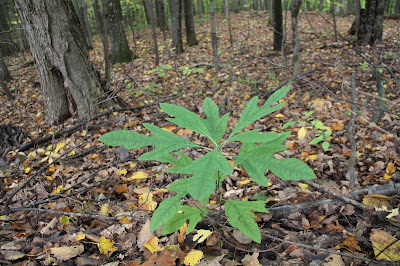Winn Elementary students are no strangers to Audubon Woods. Located only a few miles from the school, Audubon Woods is a great place for them to put science concepts into action. For the the Third Graders, this was their first trip to Audubon Woods as a class; Fourth and Fifth Graders have made multiple trips the preserve, beginning in Third Grade.
 |
| It was homecoming for Shepherd Public Schools - that explains all the blue and yellow (including the hair) |
Before the trip to Audubon Woods, I had visited each grade in the classroom at least once. Third Grade began the year learning about trees - their parts and adaptations, how to age a tree and measure diameter, and learning to classify leaves. My Fourth Grade presentation focused on plant adaptations and how plants use adaptations to overcome challenges. The Fifth Grade program repeated much of the information from Third Grade, but with a deeper emphasis on adaptations and using growth ring patterns to analyze past growing conditions.
In the woods, the focus shift a little. Here I ask all three groups of students to measure diameter of trees. While in the classroom this was easy - students simply measured the distance across prepared slices of tree trunk (AKA "tree cookies"). In the woods this is not an option. Instead students must measure the circumference (distance around) of the tree and divide that by pi (approx. 3.14) to find diameter.
 |
| Measuring circumference with a tape measure |
For Third Grade students this can be quite a challenge. They have to be able to measure the circumference with a tape measure, convert that that circumference from feet and inches to all inches, and finally use a calculator to divide by pi to find the diameter. We do one tree as a whole group before the students measure two more trees on their own.
 |
| Calculating diameter |
Fourth Graders should be able to do all of these things on their own. Just as a refresher, we go over one tree as a group and then they measure three trees on their own.
Fifth Graders have already done this activity as Third and Fourth Graders. They measure three trees on their own without a demonstration. This might seem like overkill, but in the Spring when the students return, the Fifth Grade students will learn a shortcut to estimating diameter - the Biltmore Stick. I just want them to have a firm understanding of how to calculate diameter before they learn the tricks to make it easier.
During this Fall visit, the classrooms have a very limited amount of time in the woods (about 1 hour to 1.25 hours for each class). This means that they have a limited amount of work to accomplish. For Third Graders, tree measurement and diameter calculation may take all of the available time. If they finish this activity, they are also given the assignment of finding, drawing, identifying, and classifying leaves. Most students do one or two leaves in the time allowed. If time is short (as it was this time), Fourth Grade students are assigned the same work, but are expected to accomplish more.
 |
| Student drawing of an American Beech leaf |
Fifth Grade students are given two additional activities to complete. First they are asked to determine the total number of leaves to be found on the forest floor. Audubon Woods is forty acres! This seems impossible, but it is a much less daunting task if broken into parts.
 |
| Counting every leaf in one square foot section of forest |
Instead of counting every leaf on the forest floor, students are asked to count the number of leaves in a single square foot of the forest. This number is then multiplied by the number of square feet in an acre. An acre measures 43,560 square feet. Then that number is multiplied by the number of acres in the forest.
Using this method, six groups of students came up with estimates ranging from 179 million to 390 million leaves on the floor of Audubon Woods. The average of the six groups was approximately 254 million leaves!
Once students have found an estimate of the number of leaves, they are then tasked with finding the weight of all the leaves on the forest floor. This is accomplished by determining the average weight of a single leaf and multiplying by the number of leaves in the forest.
To find the weight of a single leaf, students count out 100 random leaves from the forest floor. The leaves are placed in a plastic bag and weighed (in grams). Next the weight of the bag (already known) is subtracted. This number is then divided by 100 to find the average weight of an individual leaf.
Estimates for the weight of the leaves on the floor of Audubon Woods ranged from 100 thousand kilograms to 241 thousand kilograms with an average of approximately 138 thousand kilograms of leaves! Converted to pounds this more than 304 thousand pounds. (If you had the equivalent weight in $1 bills, you would have approximately $138 million dollars!)
Why are all of these leaves important? They provide the organic matter (humus) that is providing food and homes for billions of bacteria, fungi, and invertebrates such as insects. These organisms break down the organic matter into forms that can be taken up by plants (including trees). Essentially by releasing their leaves, the trees are providing food for themselves.
Here are a few more photographs from the day.











No comments:
Post a Comment